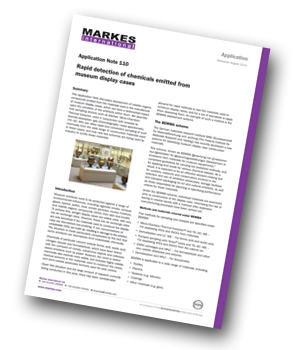Markes International has produced an application note describing the rapid detection of volatile organic compounds (VOCs) emitted from museum display cases using a sampling device in conjunction with analysis by thermal desorption–GC-MS.
 Introduction
Introduction
Amongst the chemicals for concern are highly volatile residual solvents in the materials used to construct the cases, and semi-volatile pesticides formerly used for pest control. There has been considerable demand for rapid methods to test these materials and for a set of standards to apply when assessing them. An example of such a method is the BEMMA (Bewertung von Emissionen
aus Materialien für Museumsausstattungen [Assessment of emissions from materials for museum equipment]) assessment scheme, which comprises guidelines for carrying out analytical methods, and
for applying limit levels for various chemical classes.
Sampling and Analysis Methods
Markes’ Micro-Chamber/Thermal Extractor™ (μ-CTE™) forms a key component of the sampling setup specified under BEMMA. It is a compact unit with four or six small cylindrical chambers, suitable for sampling chemical emissions both from finished products and from the corresponding raw materials. In conjunction with TD–GC–MS analysis, it has become very popular for the fast, inexpensive screening of materials as part of the monitoring of compliance with industry regulations.
Conclusion
A number of technologies, including TD–GC–MS, will be of value in helping the museums sector to
protect artefacts from damage due to volatile chemicals. In particular, Markes’ Micro-Chamber/Thermal Extractor, by being cited in the BEMMA method, is expected to play a key role, by providing a fast, reliable and versatile means for assessing volatile emissions from display case materials.
Download this application note and:
- Learn about how thermal desorption and related technologies can tackle this problem
- Learn how Markes International technology offers a solution




